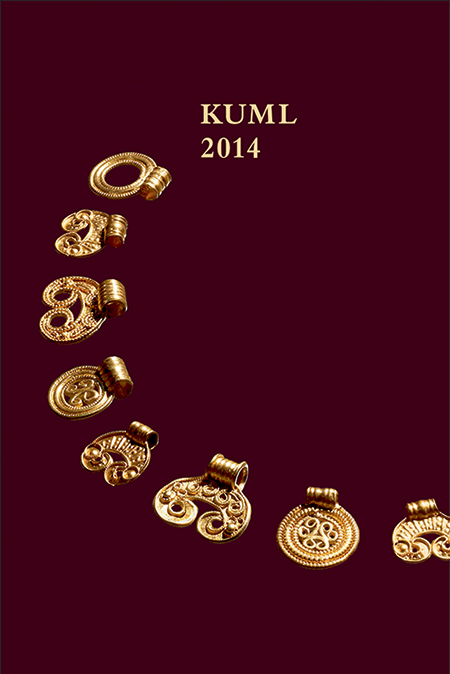Iøjnefaldende arkitektur – Nordens middelalderlige rundkirker
DOI:
https://doi.org/10.7146/kuml.v63i63.24466Nøgleord:
arkitektur, norden, middelalder, rundkirkerResumé
Conspicuous architecture. Medieval round churches in Scandinavia
The aim of this article is partly to argue why round churches were built and partly to present an updated overview of Scandinavian round churches.
Round churches (fig. 1) are often seen as something unusual, deviant and mysterious, and in need of special explanation. Thus the most recent overview for many of them, the influential Swedish dissertation Nordens befästa rundkyrkor – The fortified round churches of Scandinavia – by Hugo F. Frölén from 1910‑11, states (wrongly) that all round churches were fortified.
Today (2014), 34 round churches are known in Scandinavia (fig. 2). They are distributed as follows: There are 19 in Medieval Denmark: St. Michael in Schleswig; Thorsager and Malling in Jutland; Horne on Funen; Bjernede, Farendløse, Himlingøje, Hørve, Pedersborg, All Saints in Roskilde, Selsø, Store Heddinge (octogonal nave) and Søborg, all on Zealand; Helsingborg and Valleberga in Scania; Ny, Nylars, Ols and Østerlars, all on Bornholm. Medieval Sweden has 13 round churches: Hagby and Voxtorp in Småland; Borgholm on Öland; Bromma, Munsö and Solna in Uppland; Agnestad, Dimbo and Skörstorp in Västergötland; Klosterstad, Tjärstad and Vårdsberg in Östergötland; and Holy Spirit (octogonal nave) in Visby on Gotland. Medieval Norway has two examples, namely St. Olav in Tønsberg and St. Nicholas in Orphir in the Orkneys.
Their state of preservation is described, together with the history of their (re-)discovery since the 19th century. New discoveries of round churches are still to be expected, as several have been found by accident; however as a type they will remain a rarity. The presently known round churches constitute only c. 0.8 percent of Scandinavia’s 4400 medieval stone churches.
Generations of scholars have attempted to classify the round churches according to their size, plan and construction. This article focuses instead on their function and shows how round churches were functionally ‘normal’ in their regional church topography, based on an examination of six clusters, for example on Bornholm (fig. 3).
The article presents current knowledge on their chronology and social context, using the round churches of Bjernede (fig. 4) and St. Olav in Tønsberg (fig. 5) as illustrative examples. Dendrochronological analyses only exist for Voxtorp (fig. 6), where they indicate a date in the 1240s. In general, round churches relate to both the 12th and13th centuries, like the majority of Romanesque churches. Where a social context is known, the round church is an elite phenomenon. We find kings, earls, archbishops, bishops and nobility, perhaps also fraternities, as at the Holy Spirit in Visby (fig. 7). However, the popular Knights Templar must be ruled out as initiators.
Deviant church architecture, including round churches, has been explained from three major perspectives that need to be combined to include all examples (fig. 8): The theory of the defensive church, the theory of the multifunctional church and the theory of symbolic imitation.
I have found the round churches to be normal, apart from their relatively low rate of survival, their elite context and their extraordinary plan. I argue that the elite consciously chose ‘conspicuous architecture’ as a social strategy relative to status and rivalry. The concept is inspired by the concept of ‘conspicuous consumption’ introduced into sociology by Thorstein Veblen in 1899.
Frölén and others after him have interpreted round churches as memorials to the Holy Sepulchre in Jerusalem (fig. 9), built by returning crusaders or pilgrims. Crusaders in the Baltic may also have constructed round churches, for example at Valleberga (fig. 10). My study demonstrates that round churches, as icons for the crusades, were built by kings, bishops or noblemen who sought honour and who had been on a crusade or pilgrimage to Jerusalem, travelled to another place – or had chosen to stay at home.
Finally, I discuss Richard Krautheimer’s theory of medieval imitation, where selected elements represented a symbolic whole, insofar as the period was able to produce copies. The copying of buildings might be described as a ‘bricolage’. Medieval building work was an active process, whereby architectural elements from numerous sources were taken and used to create something new, as in the medieval reuse of ‘spolia’. Every building became a unique and ambiguous node in an infinite web of influences. Consequently, the creation of new typologies to classify and bring order to round churches, and the continuing hunt for foreign models in order to explain their architecture, both represent methodological dead ends.
Jes Wienberg
Institutionen för arkeologi och antikens historia
Lunds universitet
Downloads
Publiceret
Citation/Eksport
Nummer
Sektion
Licens
Fra og med årgang 2022 er artikler udgivet i Kuml med en licens fra Creative Commons (CC BY-NC-SA 4.0).
Alle tidligere årgange af tidsskriftet er ikke udgivet med en licens fra Creative Commons.


